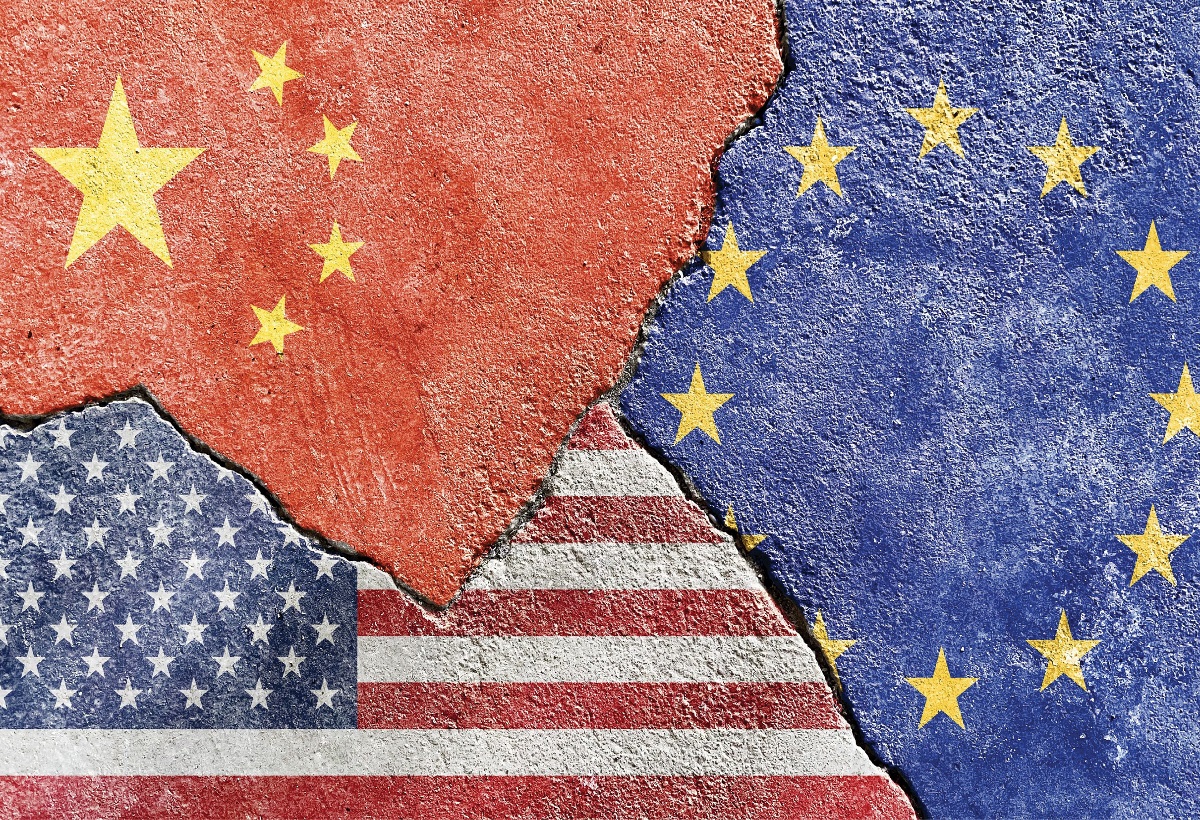
The EU economy caught between the American hammer and the Chinese anvil
Foto: Wirestock/ depositphotos.com
To the East of the West, a great distance to the West from the East, and squeezed in the middle of a war between the opposite ends of the economic spectrum. This is where the European economy stands in relation to those of the United States and China, both in fierce competition for global supremacy.
The EUobserver recently reported on the European Central Bank’s concerns about the economic rivalry between the United States and China weighing heavily on the European Union’s economy. European Central Bank’s President (and former IMF managing director) Christine Lagarde recently warned that the fragmentation of the global economy into rival blocs, led by the United States and China, threatens to destabilize world trade, increase inflation and weaken economic growth in Europe.
The United States and China compete for economic supremacy because both countries are large, powerful, and influential, with significant economic and political resources. In recent years, the problems between the U.S. and China have escalated, especially trade disputes, accusations of copyright infringements, technological rivalry, and geopolitical tensions. The U.S. government raised taxes on Chinese merchandise, while the Chinese government responded by imposing its own taxes, leading to a trade war between the two countries. The U.S. and China are also vying for technological supremacy, particularly in areas such as 5G wireless networks, artificial intelligence, and quantum computing. The U.S. government tried to limit China’s access to American technology, while China tried to strengthen its own technological capabilities through initiatives such as the “Made in China 2025” plan. The rivalry between the U.S. and China increases geopolitical tensions, as both countries seek to expand their influence and strengthen their position on the global stage. This makes things uneasy in the South China Sea and increases military spending and global political instability.
An analysis performed by the Belfer Center for Science and International Affairs at the Harvard Kennedy School points out that China’s sustained “miraculous economic growth” over the past four decades, at an average rate four times that of the United States, has redefined the global economic order. China has replaced the United States as the world’s leading manufacturing power and the largest trading partner for most nations. China has emerged as the most important link in global supply chains and replaced the U.S. as the primary driver of global economic growth. Since the 2008 financial crisis, one-third of global GDP growth has been in one country: China. By 2020, China had the most Fortune Global 500 companies in the world.
On the other hand, we cannot forget that the U.S. dollar remains the primary reserve currency at the global level, accounting for 60% of foreign exchange reserves. Competing with Beijing’s aspirations, the United States remains a leader in several key areas: the U.S. dollar is still the currency of choice for cross-border transactions, U.S. equity markets remain the largest in the world, and the U.S. is leading by a landslide in venture capital investments. In addition, as a society that attracts the world’s most talented inventors and entrepreneurs, and gives them the freedom and opportunity to pursue their dreams, the United States remains unmatched.
But economic and geopolitical tensions between China and the United States are negatively affecting European exports to both countries, reducing foreign investment in Europe, especially in strategic sectors such as technology and infrastructure, and even creating a “technological divide” as each country develops its own technologies and standards. The rivalry between China and the United States could also lead to a shift in the balance of power in global politics, as both countries seek to expand their influence and strengthen their global position, affecting Europe’s ability to influence global politics and promote its interests on the international stage.
While China made allies by defying U.S. dominance, the wealthy and democratic nations of the West have demanded greater resilience in their supply chains to guard against wars, pandemics, and attempts at coercion by authoritarian regimes, including China. Europe must find ways to address these challenges and strengthen its economic and political relations with both China and the United States. Christine Lagarde stated before the Council on Foreign Relations in New York that geopolitical strife caused by the rivalry between the United States and China could increase inflation by 5%. They could also threaten the leading position of the US dollar and the euro. Quoted by the EuObserver, Lagarde said that “a period of relative stability could now yield to a period of sustained instability, resulting in lower growth, higher costs, and more uncertain trade partnerships.” Costs tend to rise as countries stop or reduce trade with rivals and seek supplies from them or allied countries, Lagarde said, adding that disruption to global supply chains would affect “critical sectors” such as the automotive industry. The ECB managing director stressed the importance of stable global trade conditions: the United States is “completely dependent” on imports concerning 14 essential materials and Europe relies on China for 98% of its supply of rare earth elements.
At the plenary session of the European Parliament in Strasbourg on April 18, senior EU officials also called for reducing Europe’s dependence on China while maintaining the Union’s partnership with Beijing. Josep Borrell, the EU’s foreign policy chief, stated in front of the members of the European Parliament in Strasbourg that a new cold war between the “West” and the “Far East” should be avoided. Borrell said the EU should work with China because it is the biggest creditor to emerging countries and has a huge impact on the fight against climate change. “Decoupling is clearly not viable, desirable or practical for Europe, but it is obvious that Europe must work to reduce the risks associated with important and sensitive aspects of our relationship,” said the European Commission President Ursula von der Leyen to the members of the European Parliament.
The analysis performed by the Belfer Center points out that, for the first time since it overtook Britain in the 1870s to become the world’s largest economy, the United States now faces an economic rival at least as large. While the race is not always run by the fastest, nor the battle fought by the
strongest, nations with the highest GDPs have historically wielded greater power in international relations. The cited Harvard analysis shows that, as the economist Adam Smith said, trade enriches both the seller and the buyer, creating a larger “pie” for everyone. But it also creates networks of asymmetric interdependence that benefit some more than others.
And in the fierce race for supremacy between the United States and China, old Europe finds itself squeezed in a vice, its economy caught between the American hammer and the Chinese anvil.
Daniel Apostol
Share
Share















